Between 2000 and 2016, Tiit Maran, director of Tallinn Zoo, has released European minks at three different locations, one of which is a glorified chicken coop. The cages were filled with pregnant females in May, giving the mink and her family plenty of time to adjust to the scents and sounds of the forest before the doors swung wide in August.
Hiiumaa is the second-largest island in Estonia. Its natural limits, which are surrounded by the Baltic Sea, scarce population, and small surface size (989 sq km) make it a good candidate for the restoration of the European mink, which has been locally extinct in Estonia since the mid-1990s.
The European mink (Mustela lutreola), a tiny semiaquatic predator related to weasels, otters, and martens, was formerly widespread practically everywhere across Europe, from the Ural foothills to northern Spain and from Finland to the Caucasus. However, its demise in broad parts of Europe began centuries ago.
Mink Population

Scientists are unable to pinpoint a single cause for its extinction. More than likely, a series of events, all of which were triggered by humans, drove the species into extinction. Minks' marshes were drained, rivers were straightened, and their habitats were poisoned. And their furs were found in closets across the continent.
The cultivation of their distant cousins from across the sea, the American mink, dealt the fatal blow. Animals fled the industrial-scale farms regularly - or activists opened their cages. Scientists in the Soviet Union released American minks into the wild on purpose in the hopes of enhancing the fauna. The two species are similar in appearance but are not closely related, yet they seek the same ecological niche.
On the other hand, the European mink is no match for its more intelligent, adaptable, and aggressive American equivalent. The American mink pushed the European mink to less desirable areas, where it found less food and failed to breed.
IUCN Declaration
According to the International Union for Conservation of Nature (IUCN), the European mink is one of Europe's most endangered carnivores. The species may be found in limited numbers in Spain, France, Romania, and Estonia, part of the European Union. On the other hand, the American mink may be found in around 20 nations across Europe.
Ecologists are still working to safeguard the European mink's few remaining habitats from invasive species. Tragsatec, a government institution in Spain that traps American minks that infiltrate the European mink's habitat in the Basque area, Navarre, and La Rioja, catch American minks entering the European mink.
Possible Extinction
The European mink would be extinct locally if these steps were not taken, according to Madis Pdra, an Estonian researcher residing in Spain. "Minks from the United States spread quickly. The only way for the European mink to survive is via active management."
Biologists at the Tallinn Zoo keep an eye on the European mink's gene pool. The breeding facility is now closed due to the potential for Covid-19 to have fatal implications for minks - Tallinn is home to more than half of Europe's captive minks, and an epidemic would be disastrous. "We'd lose our conservation work's backbone," Maran argues.
When the animal vanished from the Estonian forest, Maran devised a plan to repopulate Hiiumaa with European minks produced in captivity. Trappers first killed the American minks that had escaped from the island's now-defunct fur farm, and then Maran's team released the first batch of European minks in 2000.
The reintroduction did not go off without a hitch. Most captive males showed little interest in mating and often acted violently toward their companions.
Stabilizing Population
The population has finally stabilized after more than 500 minks had been released. Hiiumaa is home to between 160 and 250 minks in the fall, with the population dropping to fewer than half in the winter.
Hiiumaa is a classic example of a fragile habitat for endangered species. Small populations are more vulnerable to extinction due to natural disasters, forestry, agriculture, or a particularly harsh winter.
In addition to becoming extinction hotspots, islands may also serve as refuges for species in trouble elsewhere.
Striving to Improve Mink Survival
Maran, who no longer works in the field, strives to improve the mink's survival prospects by teaching others at the zoo. He divides environmental protection into two timeframes: short-term and long-term.
"Although I have dedicated my entire life to it, the reintroduction of the mink is a short-term endeavor. But if we, as humans, do not adapt, it will all be for naught."
Related Article : One of the World Largest Mass Extinctions May Have Been Triggered by Volcanic Winter
For similar news, don't forget to follow Nature World News!
© 2025 NatureWorldNews.com All rights reserved. Do not reproduce without permission.





